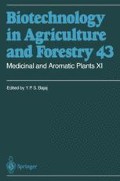Abstract
Anagallis arvensis L. (family Primulaceae) the common scarlet pimpernel, also called poor man’s weather glass, because its flowers close before rain (Chevallier 1996), is a creeping annual herb with simple leaves and solitary axillary bisexual tubular flowers. It prefers waste land and untended sandy ground. This plant is a rich source of saponins (Table 1), and has been put to numerous uses. In India it is known by the common name jonkmari and used medicinally for gout, leprosy, epilepsy, and cerebral affections (Mathur 1965). In China it is a folklore remedy for snake bite and hydrophobia (Su Ching New Medical College 1977), while in Europe it is used as a diuretic (Stuart 1988). It has also been used for gallstones, liver cirrhosis, lung problems, urinary infection, kidney stones etc. The pattern of uses suggests a detoxifying action. It is also reported to stimulate the coughing up of mucus and help recovery from colds and flu (Chevallier 1996). It has antiviral activity against Herpes simplex virus type and polio virus (Amoros and Girre 1987), and fungicidal properties (Heitz et al. 1971).
Access this chapter
Tax calculation will be finalised at checkout
Purchases are for personal use only
Preview
Unable to display preview. Download preview PDF.
References
Amoros M, Girre RL (1987) Structure of two antiviral saponins from Anagallis arvensis. Phytochemistry 26: 787 - 791
Bajaj YPS (1972) Effect of some growth regulators on bud formation by excised leaves of Torenia fournieri. Z Pflanzenphysiol 66: 284 - 287
Bajaj YPS, Dionne LA (1967) Growth and development of potato callus in suspension cultures. Can J Bot 45: 1927 - 1931
Bajaj YPS, Mäder M (1974) Growth and morphogenesis in tissue cultures of Anagallis arvensis. Physiol Plant 32: 43 - 48
Chevallier A (1996) The encyclopedia of medicinal plants. Dorling Kindersley, London, pp 164165
Glombitza KW, Kurth H (1987) Die Strukture einiger Triterpensaponine aus Anagallis arvensis. Planta Med 53: 548 - 555
Heitz S, Billet D, Raulais D (1971) Triterpenes d’Anagallis arvensis L. (Primulacee). I. Structure de l’anagalligenone B. Bull Soc Chim Fr 6: 2320-2324
Henry M (1989) Saponaria officinalis L.: in vitro culture and the production of triterpenoidal saponins. In: Bajaj YPS (ed) Biotechnology in agriculture and forestry, vol 7. Medicinal and aromatic plants II. Springer, Berlin Heidelberg New York, pp 431 - 442
Mahato SB, Sahu NP, Roy SK, Sen S (1991) Structure elucidation of four new triterpenoid oligoglycosides from Anagallis arvensis. Tetrahedron 47: 5215 - 5230
Mathur RC (1965) Systematic botany. Agra Book Store, Agra 338 pp
Murashige T, Skoog F (1962) A revised medium for rapid growth and bio-assays with tobacco tissue cultures. Physiol Plant 15: 473 - 497
Shoji N, Umeyama A, Yoshikawa K, Arihara S (1994a) Structures of anagallosaponins I-V and their companion substances from Anagallis arvensis L. Chem Pharm Bull (Tokyo) 42: 17501755
Shoji N, Umeyama A, Yoshikawa K, Arihara S (1994b) Triterpenoid glycosides from Anagallis arvensis. Phytochemistry 37: 1397 - 1402
Stuart M (1988) In: Nanba T (ed) The encyclopedia of herbs and herbalism. Enterprise, Tokyo, p 39
Su Ching New Medical College (1977) Dictionary of Chinese materia medica. Shanghai Science Technology Publishers, Shanghai
White PR (1943) A handbook of plant tissue culture. Cattel Press, Tempe, Arizona
Author information
Authors and Affiliations
Editor information
Editors and Affiliations
Rights and permissions
Copyright information
© 1999 Springer-Verlag Berlin Heidelberg
About this chapter
Cite this chapter
Bajaj, Y.P.S. (1999). Anagallis arvensis L. (Common Pimpernel): In Vitro Culture, Regeneration of Plants, and the Formation of Anagalline and other Saponins. In: Bajaj, Y.P.S. (eds) Medicinal and Aromatic Plants XI. Biotechnology in Agriculture and Forestry, vol 43. Springer, Berlin, Heidelberg. https://doi.org/10.1007/978-3-662-08614-8_1
Download citation
DOI: https://doi.org/10.1007/978-3-662-08614-8_1
Publisher Name: Springer, Berlin, Heidelberg
Print ISBN: 978-3-642-08363-1
Online ISBN: 978-3-662-08614-8
eBook Packages: Springer Book Archive

